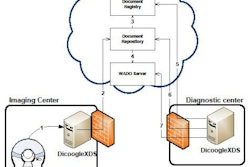
New IT tools can help radiologists who are reporting "in the dark" enhance their clinical visibility, delegates heard in Barcelona at the professional challenges seminar held at the recent European Society of Gastrointestinal and Abdominal Radiology (ESGAR) meeting.
The emergence and integration of electronic patient records (EPR) and clinical decision support (CDS) systems in hospitals, combined with the growing use of RIS/PACS for the timeliness of image and report delivery, and the development of software tools to assist therapy, are vital for overcoming today's challenges, according to Dr. Davide Caramella, head of radiology at the Santa Chiara Hospital, Pisa, Italy, and president of the 2012 Computer Assisted Radiology and Surgery (CARS) congress.
 Reporting in the dark is a disturbing situation, noted Dr. Davide Caramella.
Reporting in the dark is a disturbing situation, noted Dr. Davide Caramella.
The prevalence of RIS/PACS means information transmitted from the radiology department to patients, other clinicians, and surgeons has overtaken that of any other medical discipline, he continued. While providing rich data to others -- including annotated images and imaging data, postprocessed images, detailed reports, and modeling that can assist in the treatment process -- radiologists are not as good at procuring such information from other colleagues for themselves, and have little access to clinical systems that contain patient data.
"Reporting in the dark is a disturbing situation that we radiologists have been growing accustomed to," Caramella said.
When radiologists can access a clinical IT system to gain such information, Integrating the Healthcare Enterprise (IHE) standards and cross-enterprise document sharing (XDS) capacity are useful and allow for the management of different sources of information, enabling the end user to view images and clinical data together.
"For sure, the electronic patient record is the solution, but it is not universally available," he noted, adding that the second challenge presents itself in clinical interaction. "Clinicians see radiology as a very intricate environment and radiologists have to help them to find their way into it and welcome them."
In his experience, clinicians who have concerns about choice of examination will email him with their questions, and this sort of interaction is helpful for establishing a fruitful relationship with the clinician. In terms of daily management and coherence, IT systems that help in clinical decision-making would be beneficial, rather than doctors relying solely on one-to-one interaction, he noted. He pointed to the development of automated systems, such as ACR Select, to help in the choice of appropriate imaging, and the potential role of similar tools in European radiology.
Elaborating on the theme of communication in radiology and its impact on clinical visibility, Dr. Luis Martí-Bonmatí, PhD, head of imaging at La Fe Polytechnic and University Hospital and Quirón Hospital in Valencia, Spain, explained how the exponential growth of demand for imaging services means that as far as hospital managers are concerned, radiologists must be focused on reading films and reporting cases, in a production-based rather than clinically based work model.
 Much that goes wrong does so because of poor communication, said Dr. Luis Martí-Bonmatí, PhD.
Much that goes wrong does so because of poor communication, said Dr. Luis Martí-Bonmatí, PhD.
"Radiologists are asked to read, report, and answer clinical questions as fast as possible, meaning that there is no time to spend in personal contact with patients and referring physicians, and this in turn minimizes their perceived clinical relevance," he told ESGAR delegates.
Such time constraints have led to radiologists reducing or even abandoning less lucrative and more onerous tasks such as clinical meetings and case discussions, and this hampers recognition of their role among patients and physicians. "We should participate in multidisciplinary meetings if we really want to have an impact on the healthcare cycle and make earlier diagnoses with the right tools and find the right therapeutic approach and response to treatments," Martí-Bonmatí said.
Although it is not feasible to meet with every patient, radiologists should endeavor to obtain patient opinions by getting technicians to write them in the comment section of their own reports. Radiologists could obtain them in person when they meet with patients themselves. Interaction with patients is often critical to proper interpretation of the study and provides a means to focus the radiologist's report.
Extra communication with clinicians and patients increases workload and reduces available time for readings, as well as presenting a risk of information distortion, but it provides higher confidence in -- and greater visibility of -- radiologists' work, faster modifications to patient management, better problem-solving skills, and improved interdisciplinary discussion, he said.
"Good communication is an important professional attribute for radiologists. Much that goes wrong does so because of poor communication," Martí-Bonmatí said.
 Radiology is a clinical specialty, not a reporting service, according to Dr. Lluís Donoso Bach.
Radiology is a clinical specialty, not a reporting service, according to Dr. Lluís Donoso Bach.
Meanwhile, attention is needed at each stage of the radiological process, according to co-speaker Dr. Lluís Donoso Bach, chair of imaging at Barcelona Hospital Clinic, whose presentation covered challenges faced by radiology networks and the future professional organization of imaging.
"If radiologists report very well using technology such as CAD and teleradiology, but do not take care of the whole process, their visibility and power in the institution will be lessened," he said. "Radiology is a clinical specialty, not a reporting service."
Appropriate scheduling, quality assurance, innovations in technology, standardization, and workflow management must be prioritized, whether in a network situation or a unique institution. The most important aspect of visibility lay in the consultation between radiologists and referring clinicians, according to Donoso Bach.
"All of us do clinical specialist support, attend clinical conferences and multidisciplinary boards, [and] perform second readings and opinions. We are important in therapy planning and therapy monitoring," he said. "It is incumbent on radiologists not only to provide the highest level of service to referring physicians but also to network with clinicians and administrators."
In a network situation, direct intradisciplinary exchange between radiology professionals from different hospitals and of different levels of experience is also paramount for correct prioritization of studies and optimized performance. Subspecialty teamwork across the Barcelona network has increased the consistency of reports, productivity, and efficiency in the reading of studies, he stressed.
Speakers agreed that the provision of timely, complete, and multimedia information to clinicians, optimized by tailored use of PACS, can help to ensure the added-value service provided by radiologists was acknowledged by clinical colleagues. For radiology to have a bright future, images and reports need to be fine-tuned to therapeutic decisions, particularly in generating tailored postprocessing and modeling information in IT-enhanced oncology follow-up. Radiologists should also provide guidance for therapeutic decisions and surgical procedures, they concluded.



















